µALCR
Canadian Inst. for Advanced Research
and
Dept. of Physics & Astronomy,
Univ. of British Columbia, Vancouver, BC, Canada V6T 1Z1
This page is under construction at
/~jess/musr/
First let's talk about the acronym:
when these phenomena were first discovered in 1985-1986 at TRIUMF,
the term ``level-crossing resonance'' (LCR) was used to describe
the situation where the muon Zeeman splitting matches that of another
spin system which can thus exchange polarization with the muon ensemble
in a sort of ``flip-flop'' mutual transition.
Shortly thereafter, similar experiments were begun at PSI,
where the proponents pointed out quite correctly that the
levels never actually cross; this being an intrinsically
quantum mechanical phenomenon, the energy eigenstates of the
combined system avoid crossing, so that the proper
terminology is ``avoided level crossing'' (ALC)
[resonance].
In an effort to keep everyone relatively happy, I have adopted
the acronym µALCR, the meaning of which
I trust is obvious now to all concerned.
- Nuclear Quadrupolar µALCR:
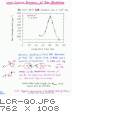
|
The first such phenomenon observed in µSR was
the resonant relaxation of muons in copper at the
longitudinal field where the muon Zeeman splitting matches
the splitting of the Cu nuclear quadrupole moment in the
electric field gradient (EFG) due to the interstitial muon.
This possibility was predicted by Anatole Abragam in 1984.
Almost the same thing was suggested a few years earlier by
Tom McMullen and Eugene Zaremba, but we misunderstood and
looked for a resonance in transverse field.
``Doh!''
|
- Paramagnetic µALCR:

|
In the case of a paramagnetic system, the unpaired electron
couples to both the muon and a nearby nucleus via
their respective hyperfine (HF) interactions, thus allowing the
muon and nuclear spins to ``flip-flop'' much more strongly
than through mere nuclear dipolar couplings.
This picture may be a little oversimplified. . . .
|
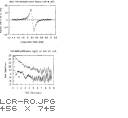
|
This was first observed in the ``muonated radical'' formed by
addition of muonium (Mu) to a double C=C bond in the
tetramethylethylene molecule. The time dependence of the
muon polarization on and off a resonant LF was also
observed at that time.
|
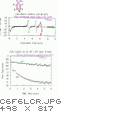
|
Similar behaviour was seen in
C6F6 µ.,
the muonated radical formed by addition of Mu to a C=C
bond in hexafluorobenzene.
|
- Applications of µALCR:
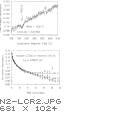
|
Quadrupolar µALCR is often used to determine
the muon site in diamagnetic solids or to confirm the formation of
a diamagnetic molecule incorporating the muon, as in this example.
(There are prettier cases, but I don't have the figures for them
handy.)
|
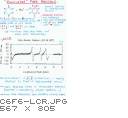
|
Paramagnetic µALCR has found many applications to
the study of radicals in chemistry, many of which are difficult
or impossible to detect by other means. Since the difference between
the ``muonated'' radical and the analogous ``hydrogenated'' version
(formed by addition of an H atom to a double bond) is mainly in the
configuration of a single bond (due to the lighter mass of the muon),
much can be learned about the behaviour and structure of such molecules
using µALCR.
|
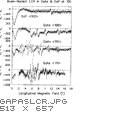
|
Paramagnetic µALCR is also an important tool
for determining the local electronic structure of the Mu* centre
in various semiconductors, where the HF couplings to various
nearby nuclei (and the orientation dependence of the µALCR
spectrum) reveal minute details of the muon's location and environment.
The examples shown are GaP and GaAs, the first
materials studied by this method. Such measurements have since
been extended to 29Si-enriched silicon and
13C-enriched diamond and well as many other systems.
|
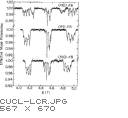
|
I include this pretty spectrum from copper chloride
just for aesthetics.
|